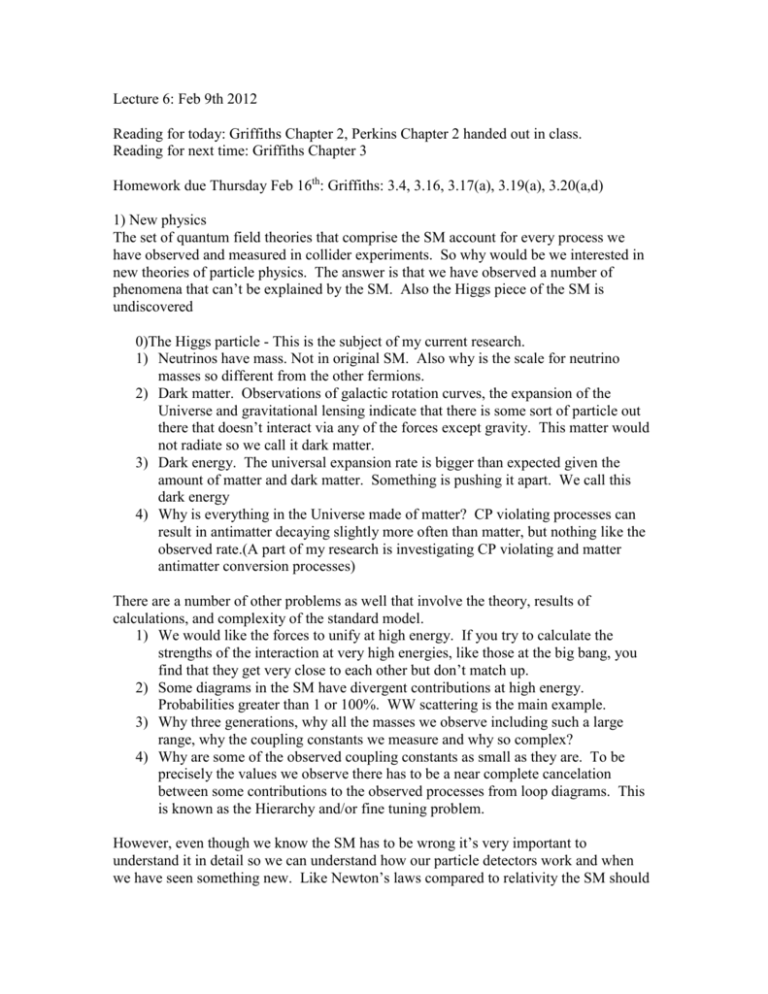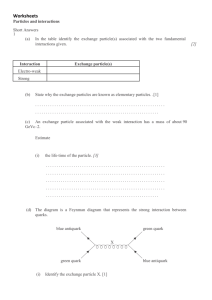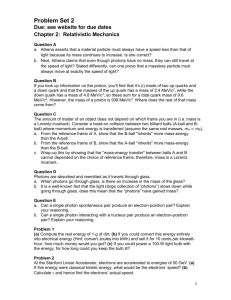lecturenotes2012_06 - University of Wisconsin, Madison
advertisement

Lecture 6: Feb 9th 2012 Reading for today: Griffiths Chapter 2, Perkins Chapter 2 handed out in class. Reading for next time: Griffiths Chapter 3 Homework due Thursday Feb 16th: Griffiths: 3.4, 3.16, 3.17(a), 3.19(a), 3.20(a,d) 1) New physics The set of quantum field theories that comprise the SM account for every process we have observed and measured in collider experiments. So why would be we interested in new theories of particle physics. The answer is that we have observed a number of phenomena that can’t be explained by the SM. Also the Higgs piece of the SM is undiscovered 0)The Higgs particle - This is the subject of my current research. 1) Neutrinos have mass. Not in original SM. Also why is the scale for neutrino masses so different from the other fermions. 2) Dark matter. Observations of galactic rotation curves, the expansion of the Universe and gravitational lensing indicate that there is some sort of particle out there that doesn’t interact via any of the forces except gravity. This matter would not radiate so we call it dark matter. 3) Dark energy. The universal expansion rate is bigger than expected given the amount of matter and dark matter. Something is pushing it apart. We call this dark energy 4) Why is everything in the Universe made of matter? CP violating processes can result in antimatter decaying slightly more often than matter, but nothing like the observed rate.(A part of my research is investigating CP violating and matter antimatter conversion processes) There are a number of other problems as well that involve the theory, results of calculations, and complexity of the standard model. 1) We would like the forces to unify at high energy. If you try to calculate the strengths of the interaction at very high energies, like those at the big bang, you find that they get very close to each other but don’t match up. 2) Some diagrams in the SM have divergent contributions at high energy. Probabilities greater than 1 or 100%. WW scattering is the main example. 3) Why three generations, why all the masses we observe including such a large range, why the coupling constants we measure and why so complex? 4) Why are some of the observed coupling constants as small as they are. To be precisely the values we observe there has to be a near complete cancelation between some contributions to the observed processes from loop diagrams. This is known as the Hierarchy and/or fine tuning problem. However, even though we know the SM has to be wrong it’s very important to understand it in detail so we can understand how our particle detectors work and when we have seen something new. Like Newton’s laws compared to relativity the SM should be considered a valid low energy effective theory consistent with the full theory in the correct energy range. Our particle detectors generally function in this lower energy range. 2) Particle detectors from inside to outside: a) The tracker. A device immersed in a magnetic field, which will be used to measure the momentum of the particle by its curvature in the field. Particle going through a gas or a solid will ionize the material by exchanging photons, which leaves the detectable track. These ions are what are detected. Also the tracks can be traced back to find if they came from a common vertex and thus could be from the decay of a more massive particle. There are two typical types of tracking detectors. Drift chambers: gas filled chambers with wires for detecting ions and silicon semiconductor sensors with metal strips for detecting ions and ionized electrons. Key physics Trackers i) typical technology is a wire drift chamber with a easily ionized gas, an electric field to to propagate the ionlization charge, and wires help at high voltage to collect the charge. ii) The chamber is immersed in a magnetic field. The tadius of curvature of a charged particle track in a solenoidal magnetic field. r = 0.3Bp where p is the momentum in GeV/c, B is in Tesla and r is the radius of curvature in meters. iii) Ionization charge drifting. The ionized particles drift toward wires that are held at high voltage. Measuring the drift time if the typical velocity is know can give a much more accurate measurement. iv) The ionization process is a scattering interaction. Probability is proportional to 2 or e4. See Perkins page 39. dE/dx has an incident particle mass dependence at relativistic speeds that can be used to distinguish the particle type. v) Scattering interactions are inversely proportional to mass so, for instance electrons are scattered frequently degrading the resolution of these detectors. vi) Large field, large chamber radius and a large number of measurements is useful to get the best momentum precision. Resolution goes as BR2 Also slow drift times will give better precision if drifting is used. vii) Typical resolution pT/pT = 0.2%pT. Gets worse at higher pT, less curvature Key physics tracking and vertex detectors i) Ionization is much larger(due to the low ionization potential) in semiconductors, which makes them an excellent particle detector material since you can design a small volume detector that can precisely determine the position of particles. ii) Low volume, multiple layer, highly segmented and precise detectors placed very near the interaction region are useful determine the origin of particles. Multiple particle production or decay at a given point will allow you to find the vertex of the multiple particle trajectories. iii) Standard technology is a silicon semiconductor with a bias voltage (voltage difference across the wafer to encourage ionization and propagation of the ionization charge) with metal held at high voltage strips for detecting the ionization energy. iv) Typical vertexing resolutions of order 10s of microns. v) Silicon detectors can also be used for momentum measurements but it requires large volume (money). The advantages are excellent precision and fast response. b)Time of flight(TOF). Precise time measurements from the scintillation light of atoms excited by the passing particle. More massive particle move slower for the same momentum. i) Momentums are measured in the tracker and velocity in the TOF and relativistic equations used to calculate the mass. ii) The active material is usually a scintillating material, which is ionized by particles traversing the detector. The ionized electrons are recaptured by atoms emitting photons, which are detected by photomultipliers. iii) A optimal detector is composed of an easily ionized material, has fast decay times for recaptured electrons and transparent materials so photons emitted after the electrons of been recaptured can be observed. c) Cerenkov detectors. Identify particles by Cerenkov light. i) When the particle velocity exceeds the speed of light in the medium v > c/n Cernkov light is emitted at an angle cos = c/vn. The particle velocity can be measured by measuring the angle or at least said to be above a certain value if the light is detected. Depending on application the best n can vary. d) Electromagnetic calorimeter. Electrons and photons will interact electromagnetically in matter. This makes a cascade or shower of electrons and photons that can be measured to determine the total energy. muons and hadrons(pions kaons protons…)tend to go through these detectors without interaction . i) Electrons will interact via brehmsstralung producing photons. An 3 probability interaction proportional to e6 or simply ionize atoms, a 2 probability interaction. Photons (primary or secondary from electrons) will Compton scatter, pair produce an electron and a positron, or, once low enough energy, be absorbed photo-electrically. Pair production is an 3 probability interaction, Compton scattering 2 and and photoelectric absorption . However, Compton scattering and photoelectric absorption have energy dependences of 1/E and 1/E3. As the energy of the photons goes down after repeated interaction dividing the energy among many photons and electrons you see a progression from pair production dominating to Compton scattering to photoelectric absorption. Having a dense material with a high Z will make these interactions more likely. The secondary particles will continue to interact until all the electrons produce photons that are too low energy to ionize new electrons and these photons are measured by photomultipliers. ii) Good materials for this type of detector are characterized by the radiation length, X0, the length of detector material electrons or photons will traverse before 1/e of the particles interact, and the Z of the material. You would like small X0 and large Z. X0 tends to be small and Z large for heavy materials like iron X0=13.8, Z=26 and lead X0=5.8, Z=82. Also low X0 reduces the lateral spread of the shower or Moliere radius giving better position/angular resolution. iii) Also once you are down to lower energy photons you would like to have a transparent material. Lead glass is a good example. iv) These interactions are also characterized by the length, L, until the shower is done which is proportional to the energy of the incident particle. For higher energy application you will need a deeper calorimeter. v) Some designs sample the energy at several points and include a special array of detectors that measure energy and show shape at the place where the energy deposition is the greatest, shower maximum. This maximizes the collected energy and gives the best precision. In these cases the active material does not have to be transparent since you can interleave the active material with transparent layers such as scintillators to collect the electrons and light. vi) Typical resolution E/E = 5%/root(E). Gets better with more energy since there is more secondary electrons and photons to sample. e) Hadrons will interact strongly in dense matter such as iron and the energy of the resulting particles can be measured. Muons will go through without much interaction. i) These interactions will happen for charged or neutral hadrons, both have color charge. ii) The scale of interaction length or absorption length, 0, is different since we are talking about the strong interaction. These lengths are actually larger since the hadrons have to get near within the typical strong force distance of the nucleus before there is a good probability of interaction. iii) The interactions produce new charged and neutral hadrons with can undergo a shower of secondary interactions. The energy that is eventually detected is from ionization caused by the many charged hadrons produced in the shower. Also the lightest neutral meson, a pion, will decay electromagnetically to two photons, which can be detected. A substantial portion of energy is lost to nuclear breakup, which can be detected if you material is U238 which will undergo fission when hit by fast neutrons and the photons from the fission process can be detected. iv) Good materials should be high A. You typically use a material like iron or Uranium, which is not that transparent. Therefore you must alternate layers of metal and scintillator which are used with photomultipliers to collect the light or ionized electrons. An alternative is measuring device such as drift tubes in streamer mode to count the number of particles. v) One of the best designs is a Uranium compensating (same response to hadronic or EM particles) calorimeter. vi) Typical resolution E/E = 50%/root(E) f) Muon systems typically sit outside the large amount of metal of the hadronic calorimeter. They may consist of drift tubes, small version of the drift chamber to spot the charged muons. You can put them in a field to measure momentums. g)If you measure everything then any left over energy you expected is probably lost in to neutrinos or other unobserved particles. 3) Particle physics and detectors application: Top quark discovery. The top quark was discovered 15 years ago during the first run of the Fermilab Tevatron at the CDF and D0 detectors. Wisconsin participated in the CDF effort. It’s mass is approximately 170 GeV or more precisely 173.3+-1.1 GeV/c2. The high mass of the top quark explains why it took so long to discover it, since it needed a very high energy collider. Production. The top quark is produced by a quark anti-quark pair annihilating to a gluon and the gluon splitting (pair producing) a top and anti-top pair. Since the quarks only carry on average a little less than one third of the momentum of the entire proton you need a very high energy collider to produce top anti-top pairs. Having more that the necessary energy makes the cross section for top production larger. The top quark can also be produced by two gluons fusing to a virtual gluon or a signal gluon splitting to a top anti-top pair(where one is virtual), which interacts with a second gluon to conserve momentum and energy. These two diagrams a typically called s channel (virtual gluon) or t channel (virtual top). Decay: The top quark decays to a W+ and a b quark. Technically the top quark could also decay to s or even a d quarks. However, the probabilities according to the CKM matrix are extremely small. The b quark is almost 100% in the b flavor weak eigenstate. Also note that since the top quark has a mass of 173 GeV there is enough energy available when it decays for the W and b to be created. We say that the W is on mass shell. Previously we discussed the weak force as being short range and thus weak because the energy had to be borrowed for a short amount of time. A second way to think about this is that the W, or the Z, has a probability distribution as a function of mass. You can create a virtual W particle far away from its standard mass but that has a very low probability. The dominant portion of the probability is close to the median value. The strength of the coupling is determined by multiplied by the probability for the W to exist at that mass. Far from the median W mass this product is on order 10-5. Note you get the same from qualitative behavior the uncertainty principle idea. The Breit Wigner probability density function (pdf): P = 1/((E2-M2) 2+M22) where is known as the width and is the inversely related to the lifetime. Note that this is clearly a relativistic equation. We’ll find this comes from the term for the virtual particle in the full calculation of the probability of these interactions. The W+ can be produced at it’s median mass value and the decay of top to W+ and b is the dominant decay. Therefore this decay happens at very high probability. In fact the top quark decays before it can even interact with the anti-top quark via QCD and form new quarks out of the vacuum. We say it decays before it can hadronize. Next the W+ will decay. It can decay to a lepton and a neutrino (electrons and muons are easiest to detect) or it can decay to quarks. Naively, you would expect that the W+ can decay to e+, +, +, u anti=d, c anti-s, all with equal probability. However, the quark pairs can have three different color anti-color combinations so those decays happen 3 times as often. This is a clear indication that color exists! If the W decays to leptons they can be easily detected. In the electron case you’ll need an electromagnetic calorimeter deep enough to absorb all the energy of the high momentum electron. In the muon case you will need muon chambers with enough material in front of them to reduce backgrounds from fake muons. The tau case the most difficult since the will quickly decay to several lighter particles. For instance, lighter leptons and neutrinos, + -> W+ -> + anit- or neutrinos or quarks + -> W+ -> u anti-d . If the W decays to quarks the quarks will have significant momentum and as they spread apart many other quark anti-quark pairs will be formed. This will form two jets of hadrons which will be detected in the hadronic calorimeter. Two jets because the W is very heavy and the quarks will move in opposite directions. The jets will also be very energetic and you need a deep hadronic calorimeter to measure the jet energy. The b quark will hadronize to b hadrons. The hadronization process will produce a jet with one of the particles in the jet being a b hadron. These hadrons have a long lifetime since the only decays possible for the b quark cross quark generations making them low probability. The long lifetime means that the b hadron travels a significant distance, half a millimeter, before decaying! This distance is far enough that a jet containing a b hadron can be distinguished from other types of jets using a vertex detector. Note to calculate the b lifetime you also have to take into account the time dilation factor. The small distance the b hadrons travel is why we have to build such precise inner detectors to spot them. In order to spot top events you need to tell them apart from other events. Since QCD processes are high probability the vast majority of events produced will be quark antiquark events usually involving lighter quarks. In fact you have to separate the top events from millions of uninteresting events. However you can use the features of the top decays. The leptons are easy to detect and not produced in typical QCD events. The b quarks can be detected from their long lifetime. Decays were one top decays to a Wb and the W to a lepton and the other top decays to a Wb and the W decays to jets is easy to distinguish. The leptons are unusual, there is only one neutrino so it’s energy can be inferred, and there are two b quarks with long lifetimes. Events where both Ws decay to leptons are are the easiest to detect by there are two missing neutrinos and they are rare. Events where both Ws decay to jets of hadrons are very difficult. Note that CKM factors for going from the 3rd to the other generations are quite small. The size of the factors comes from the difference in the masses between the generations. The larger the difference the smaller the factor. Thus the massiveness of the top quark contributes to the lifetime of the b hadrons by excluding inter generation decay, which in turn makes the top easier to detect. Note also that colliders tend to run in a mode where we have millions of collisions per second. We need a system that can make decisions on microsecond time scales about what collision events we are interested in keeping for further study.








